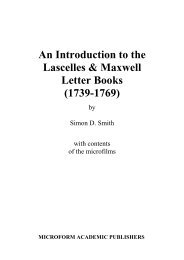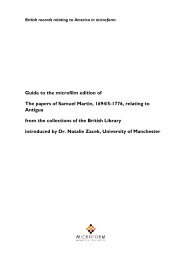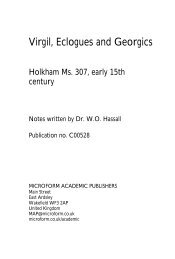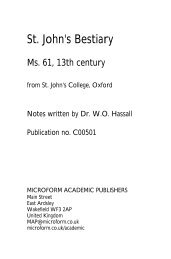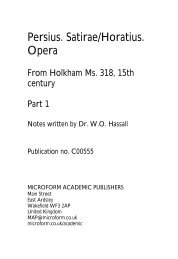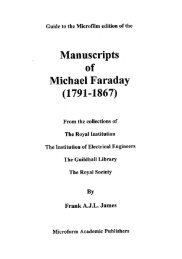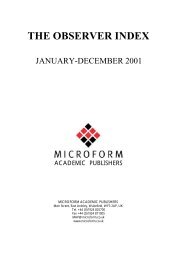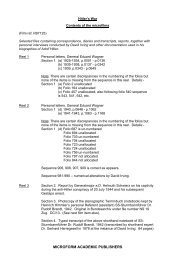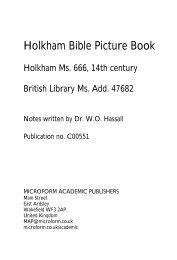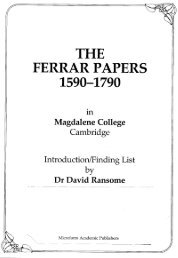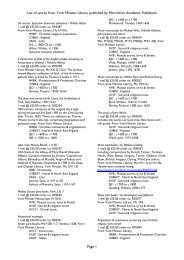An introduction to the plantation journals of the Prospect ... - Microform
An introduction to the plantation journals of the Prospect ... - Microform
An introduction to the plantation journals of the Prospect ... - Microform
Create successful ePaper yourself
Turn your PDF publications into a flip-book with our unique Google optimized e-Paper software.
Barclays Group Archive? The solution <strong>to</strong> this mystery probably lies in Stephen<br />
Oakeley Attlay Sr.’s response <strong>to</strong> <strong>the</strong> abolition <strong>of</strong> slavery, coupled with <strong>the</strong> decision <strong>of</strong><br />
his son and heir not <strong>to</strong> pursue a business career. In 1834, <strong>the</strong> parliamentary<br />
commissioners charged with compensating slave owners valued <strong>Prospect</strong>’s 141<br />
enslaved workers at £6,420 sterling. Oakeley Attlay Sr. assigned <strong>the</strong> resulting<br />
compensation award <strong>of</strong> £2,809. 19s. 1d. <strong>to</strong> <strong>the</strong> merchant partnership <strong>of</strong> Jegon and<br />
Ru<strong>the</strong>rford, who had granted him a mortgage <strong>of</strong> £5,842. 12s. 9d. At <strong>the</strong> time <strong>of</strong><br />
emancipation, <strong>Prospect</strong> also carried an additional debt <strong>of</strong> £1,000 owed <strong>to</strong> <strong>the</strong><br />
merchants Langmead and Jordan. This second loan was also paid <strong>of</strong>f as part <strong>of</strong> <strong>the</strong><br />
settlement with <strong>the</strong> compensation commission. 25 Though <strong>the</strong> net financial positions<br />
<strong>of</strong> Stephen Attlay and his son at <strong>the</strong> time <strong>of</strong> <strong>the</strong>ir decease cannot be determined, it is<br />
striking that by 1834 <strong>Prospect</strong> had itself become encumbered by debt, in contrast <strong>to</strong><br />
<strong>the</strong> position in 1786 when debts were owed <strong>to</strong> <strong>the</strong> Attlay estate from local planters.<br />
Oakeley Attlay Sr. died in 1839, <strong>the</strong> year following full emancipation on<br />
Jamaica. His son and namesake was <strong>the</strong> Revd. Stephen Oakeley Attlay Jr., vicar <strong>of</strong><br />
St. Stephen’s church, Norwich. 26 Portland had always been marginal land for sugar<br />
cultivation and it was not <strong>to</strong> revive as an agricultural area until <strong>the</strong> banana tree (a<br />
crop better suited <strong>to</strong> <strong>the</strong> region’s relatively high precipitation levels) was introduced.<br />
By <strong>the</strong> end <strong>of</strong> <strong>the</strong> four year period <strong>of</strong> slave ‘apprenticeship’ in 1838, only 112 workers<br />
were left at <strong>Prospect</strong>, signifying that sugar and rum production was in <strong>the</strong> process <strong>of</strong><br />
being run down. 27 It appears probable, <strong>the</strong>refore, that <strong>Prospect</strong> was disposed <strong>of</strong><br />
shortly after <strong>the</strong> death <strong>of</strong> Oakeley Attlay Sr. and that <strong>the</strong> <strong>plantation</strong>’s <strong>journals</strong> were<br />
deposited with Ransom and Company during <strong>the</strong> winding up <strong>of</strong> his estate. If this<br />
hypo<strong>the</strong>sis is accepted, it is likely that <strong>the</strong> bank acted as trustees for <strong>the</strong> Revd.<br />
Oakeley Attlay Jr. and was responsible for administering <strong>the</strong> various legacies<br />
charged on <strong>Prospect</strong> that were assigned along with <strong>the</strong> compensation claim.<br />
There are thus no direct links between Barclays Bank and <strong>the</strong> owners <strong>of</strong><br />
<strong>Prospect</strong> Estate. On Jamaica, Stephen Attlay’s business associates included a<br />
George Barclay (Attlay’s partner in <strong>the</strong> victualling trade during <strong>the</strong> Seven Years’ War<br />
was one George Barclay), whilst <strong>the</strong> list <strong>of</strong> deb<strong>to</strong>rs owing Attlay’s estate money<br />
refers <strong>to</strong> a James Barclay. A <strong>plantation</strong> named Barclay’s was also in operation in<br />
Portland parish in 1804. None <strong>of</strong> <strong>the</strong>se circumstances, however, explain <strong>the</strong><br />
subsequent deposit <strong>of</strong> <strong>Prospect</strong>’s records in <strong>the</strong> Barclays Archive, and <strong>the</strong>re is also<br />
no evidence <strong>to</strong> link any <strong>of</strong> <strong>the</strong>se individuals <strong>to</strong> <strong>the</strong> Bank. Barclays itself grew out <strong>of</strong> a<br />
late 17th century London goldsmith partnership, as did several o<strong>the</strong>rs in <strong>the</strong> decades<br />
after <strong>the</strong> civil war. Sometime later <strong>the</strong> Barclays entered in<strong>to</strong> a marriage and banking<br />
alliance with ano<strong>the</strong>r Quaker family, <strong>the</strong> Gurneys <strong>of</strong> East <strong>An</strong>glia.<br />
<strong>Prospect</strong> Estate represented a last link between <strong>the</strong> Attlays and slavery in <strong>the</strong><br />
Caribbean, but how long had this family connection existed? In 1832, <strong>the</strong> Bridgwater<br />
and Somerset Advertiser recorded <strong>the</strong> marriage <strong>of</strong> <strong>the</strong> ‘Revd. Stephen Oakley Attlay<br />
<strong>of</strong> Teignmouth’ <strong>to</strong> Ca<strong>the</strong>rine Robinson <strong>of</strong> Ilfracombe. As has already been noted,<br />
Attlay’s fa<strong>the</strong>r was a direc<strong>to</strong>r <strong>of</strong> a Bridge Company at Teignmouth. The regional<br />
connection is fur<strong>the</strong>r streng<strong>the</strong>ned by Oakley Attlay Sr.’s draft will <strong>of</strong> 1817, which<br />
names as trustee <strong>the</strong> Revd. Henry Woollcombe <strong>of</strong> <strong>the</strong> nearby community <strong>of</strong> Ashbury.<br />
Indeed, <strong>the</strong> surname ‘Attlay’ may be derived from <strong>the</strong> place name ‘Ha<strong>the</strong>rleigh’,<br />
5



